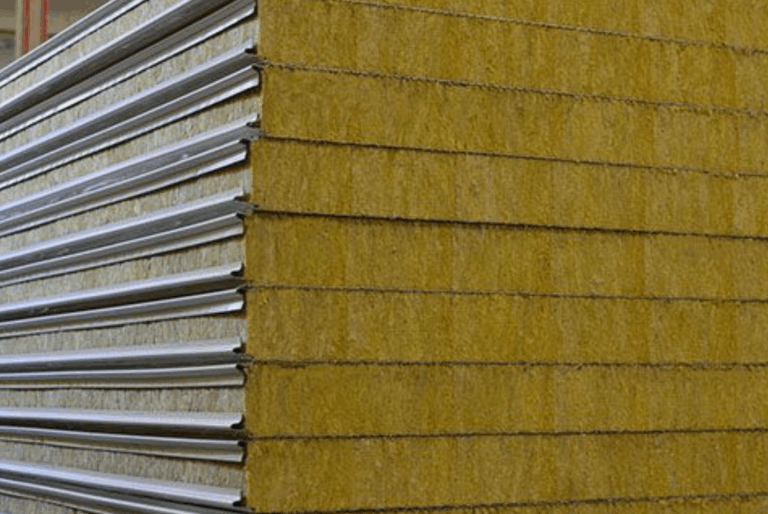Learn about the fire resistance of sandwich panels, their classifications, and how to select the best option for construction projects in the U.S. Discover fire ratings, safety standards, and best practices for compliance and durability.
Fire resistance is a crucial factor in the construction industry, especially when using sandwich panels for walls, roofs, and facades. These panels offer excellent thermal insulation and structural support, but their fire performance varies significantly based on core materials and construction techniques.
This guide provides essential insights into the fire behavior of different sandwich panel types, fire safety standards in the U.S., and key factors to consider when selecting fire-resistant panels.
Types of Sandwich Panels and Their Fire Resistance:
The fire resistance of sandwich panels depends primarily on the core material. Below, we compare the most common options:
- Mineral Wool Core Panels
-
- Fire Rating: A2-s1, d0 (Non-combustible)
- Fire Resistance: Up to EI 240 (Can withstand fire for up to 4 hours)
- Best Use: High-risk applications requiring maximum fire safety.
Mineral wool panels offer the highest fire resistance, maintaining structural integrity even under prolonged exposure to hot temperatures.
- Polyisocyanurate (PIR) Core Panels
-
- Fire Rating: B-s1, d0 or C-s3, d0.
- Best Use: Commercial buildings requiring a balance between fire safety and insulation.
PIR panels provide moderate fire resistance while maintaining good thermal insulation properties.
- Polyurethane (PU) Core Panels
-
- Fire Rating: D-s3, d0.
- Best Use: Energy-efficient applications where fire risk is lower.
PU panels excel in thermal insulation, but their fire resistance is limited compared to mineral wool and PIR panels.
Understanding Fire Ratings and Testing Standards:
In the U.S., sandwich panels are assessed using strict fire performance standards to ensure compliance with building codes. The most relevant fire resistance tests include:
ASTM E84 – Surface Burning Characteristics of Building Materials
NFPA 285 – Fire Propagation in Exterior Wall Assemblies
UL 263 – Fire Tests of Fire Resistance of Building Construction and Materials
These certifications determine the flame spread, smoke production, and fire resistance duration of sandwich panels in real-world conditions.
Fire Classification System (Euro class Standard):
The Euro class system also helps classify fire performance:
| Class | Fire Contribution |
| A1, A2 | Non-combustible |
| B | Extremely limited |
| C | Limited |
| D | Medium |
| E | High |
| F | No performance |
Additional indicators:
- s1, s2, s3: Smoke production (s1 = lowest smoke emission)
- d0, d1, d2: Flaming droplets (d0 = no flaming droplets)
Key Factors Affecting Fire Resistance:
- Core Material: Determines overall fire performance.
- Panel Thickness: Thicker panels resist fire for longer.
- External Cladding: Non-combustible cladding improves fire safety.
- Installation Quality: Proper sealing and fitting reduce fire spread.
Always verify that panels meet local building codes to ensure compliance with fire safety regulations.
McMillan Insulated Panels: Fire-Resistant Solutions:
At McMillan Insulated Panels, we offer a range of high-performance sandwich panels designed to meet strict fire safety standards.
Key Features:
- Wall Panels: Fire resistance for up to 4 hours, excellent insulation, and durability.
- Custom Solutions: Optimized for fire safety, energy efficiency, and acoustic performance.
- Certified Compliance: Panels assessed Euro Class Standard.
For expert consultation on selecting fire-resistant panels for your project, contact McMillan Insulated Panels today!
Applications & Considerations for Fire Safety:
When selecting sandwich panels for fire-resistant construction, consider:
- Building Type & Usage: Industrial, commercial, or residential structures may have different fire safety requirements.
- Local Fire Codes: Ensure compliance with U.S. regulations to avoid legal and safety issues.
- Cost-Effectiveness: Balance fire resistance with energy efficiency and durability.
- Proper Installation: Professional installation maximizes fire resistance and reduces risk.
Why Fire-Resistant Sandwich Panels Matter:
Using fire-rated sandwich panels provides multiple advantages:
- Enhanced Safety: Protects lives and property by reducing fire spread.
- Structural Stability: Maintains integrity during elevated temperatures.
- Energy Efficiency: Offers excellent thermal insulation while meeting fire safety standards.
- Versatility: Suitable for commercial, residential, and industrial buildings.:
By carefully selecting fire-resistant sandwich panels, construction professionals can ensure safety, durability, and compliance in all building projects.
Frequently Asked Questions (FAQ):
- What is the most fire-resistant sandwich panel?
Mineral wool core panels are the most fire-resistant due to their non-combustible properties.
- How do fire classifications work?
Fire ratings (A1-F) measure a material’s combustibility, smoke production, and fire duration resistance.
Get Expert Fire-Resistant Panel Solutions Today!
McMillan Insulated Panels offers industry-leading fire-resistant solutions. Contact us to learn more about fire-rate sandwich panels for your next construction project.





